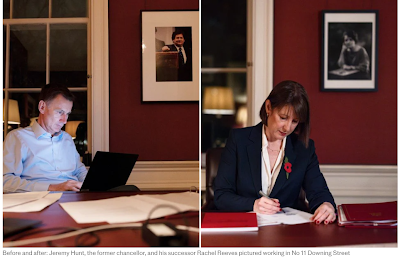A century of sensationalism and misinformation: The legacy of the Daily Mail
2 November, 2024
LEFT FOOT FORWARD
For its devoted readers, the Mail serves as a bastion of traditional British values. For its critics, the Daily Fail or the Daily Wail as it’s known, presents the worse curtain-twitching paranoia

Another was from 2022, when the newspaper faced criticism from the Muslim Council of Britain (MCB), which accused it of exacerbating hatred by attacking Conservative leadership hopeful Penny Mordaunt for meeting the MCB’s secretary general, Zara Mohammed. The MCB accused the paper of peddling negative stereotypes against Muslims.
Hasan Patel, a strategic communications expert and former journalist, criticised the Daily Mail’s “Summer of Discontent” frontpage. He argued that the paper has significantly contributed to the climate of hate that fuelled the recent riots. “You have the @DailyMailUK acting like the #FarRight #FarageRiots was due to the Labour government, yet they as a media under Dacre have a lot to answer for in the way they have whipped up hate,” Patel wrote on X.
In 2016, the Daily Mail, together with the Sun, were singled out in a report on “hate speech” and discrimination in the UK. The European Commission against Racism and Intolerance (ECRI) specifically criticised some UK media outlets, particularly tabloid newspapers, for “offensive, discriminatory and provocative terminology.”
Its report said hate speech was a serious problem, including against Roma, gypsies and travellers, as well as “unscrupulous press reporting” targeting the LGBT community.
The Mail’s long history of campaigning against the interests of the working people while claiming to be for them, also remains at play today. One example of this is how the paper’s current owner, Jonathan Harmsworth, 4th Viscount Rothermere, has the tax-avoiding ‘non-dom’ status and owns his media businesses through a complex structure of offshore holdings and trusts.
In 2015, the newspaper ran a smear campaign against Ed Miliband, in a bid to destroy his chances of becoming prime minister. Miliband had promised to remove non-domicile tax status. Little surprise there then.
The newspaper’s role as a propagandist for the Conservatives is even recognised abroad. In 2012, the New Yorker, wrote that the Daily Mail is more than just a newspaper, it is a “middlebrow juggernaut capable of slaying knights and swaying prime ministers.”
Representative of Britain’s deep sociopolitical divide
While its readership has declined from the two million copies sold in the 2000s, the Daily Mail still manages to sell approximately 800,000 copies per day . The MailOnline meanwhile attracts around 22 million unique browsers every month, making it the biggest and most engaged English-language newspaper website in the world.
It could be argued that opinions on the paper reflect the deep sociopolitical divide in Britain. For its devoted readers, it serves as a bastion of traditional British values, effectively voicing their concerns about issues such as the EU, immigration, and ‘benefit cheats.’
For its critics, the Daily Fail or the Daily Wail as it’s known, presents the worse curtain-twitching paranoia. ‘Pure xenophobia’ was how it was described in response to its outlandish outrage about England daring to appoint a foreign manager for the men’s football team

This media outrage bore familiarity to the earlier backlash Keir Starmer faced for removing a portrait of Thatcher herself from No. 10.
The Telegraph reacted strongly, with a headline labelling Wilkinson as one of the founding members of the Communist Party of Great Britain without referencing the fact that she resigned from the Party in 1924 because of its rejection of a parliamentary route to socialism.
The Daily Mail, which, as we know, has of history of linking Labour to Soviet sympathies, derisively dubbed Reeves “Red Rachel,” criticising her decision to replace “tax-cutting Tory Nigel Lawson” with an “image of ex-Communist education minister from 1940s.”
Wilkinson, who represented Middlesbrough East and later Jarrow, was a pioneering advocate for trade unionism, social justice, women’s rights, and educational reform. In her all too brief time as education minister in the post-war Labour government, (she died aged 55, her poor health aggravated by unremitting hard work) she raised the school leaving age to 15, established the Emergency Training Colleges to train more teachers, improved grants for further education, and introduced school meals and free milk.
She also contributed to the establishment of UNESCO, and was instrumental in organising the ‘Jarrow Crusade,’ a march from Jarrow to London in protest of the economic hardships faced by the North East community.
Despite these notable achievements, the Tory press jumped on the chance to undermine Reeves, by framing her choice as a nod to communism, as Wilkinson was briefly communist.
Surely, for Britain’s first female chancellor, the choice reflects her commitment to replacing all the portraits in No. 11 with pictures either of a woman or by a woman. Why on earth would Reeves want Nigel Lawson staring down at her, who was hung there by Rishi Sunak during his time at No. 11, especially as his famous tax cutting budget also triggered a sharp rise in inflation just as the Thatcher government seemed to have got it under control?
Perhaps the right-wing media could use a refresher on girl power. Why let a male tax-cutting Tory overshadow her vision for a more inclusive future? Which brings us to another point. As I write this, we don’t know who will win the Tory leadership contest, but even if Kemi Badenoch wins, it’s hard to see her promoting feminism. As the late Jill Tweedie, a respected feminist writer said about Margaret Thatcher, “She might be a woman, but she ain’t no sister.”

Gabrielle Pickard-Whitehead is author of Right-Wing Watch
For its devoted readers, the Mail serves as a bastion of traditional British values. For its critics, the Daily Fail or the Daily Wail as it’s known, presents the worse curtain-twitching paranoia
.
As the right-wing media uproar continues over the first Labour budget in 14 years, it’s a timely moment to reflect on how a century ago, the first-ever Labour government was toppled with the help of a forged letter sensationalised by the press.
What we now recognise as ‘fake news’ effectively originated on October 29, 1924, when the Daily Mail published the Zinoviev letter. The document, allegedly from the head of the Communist International in Moscow, purported to extend support to the Labour Party, triggering a political crisis that would change the course of history.
Ramsay MacDonald had led a minority Labour government for just nine months, proving that his party could be a responsible and formidable left-wing force. Yet, his Conservative opponents and their allies in the right-wing press sought to paint the Labour government as a dire threat to civilisation, alleging ties to the Soviet Union.
The closing stages of the general election 100 years ago was dominated by one of the most controversial letters of all time.
A history of misinformation
The infamous Zinoviev Letter, addressed to the British Communist Party’s central committee, was leaked to and sensationalised by the Daily Mail. Allegedly signed by Grigori Zinoviev, a prominent Bolshevik, the letter urged British and Irish communists to intensify their revolutionary activities, claiming that the Labour Party’s rise would strengthen relations with the Soviet Union. It suggested that a Labour government would radicalise the working class, positioning the Communist Party of Great Britain (CPGB) favourably for a Bolshevik-style revolution.
On October 25, just four days before the election, the Mail plastered its front page with a headline, claiming: Civil War Plot by Socialists’ Masters: Moscow Orders to Our Reds; Great Plot Disclosed.
The sensationalism proved effective, as Labour suffered a crushing defeat.
The headlines surrounding the Zinoviev Letter were the climax of `a relentless onslaught of inflammatory articles targeting the Labour government throughout the 1924 election campaign. Readers were led to believe that MacDonald’s government intended “to use British taxpayer’s credit and cash for the purpose of financing a gang of thieves and murderers who have usurped power in Russia [and] wish to destroy the British empire and our civilised system of credit.”
No accusation was too outrageous. One article even claimed that six cabinet ministers had been persuaded to accept Russian jewels hidden in chocolates.
Each day, the newspaper featured “an outstanding Conservative campaign poster released today from that party’s headquarters.”
But it was Zinoviev letter scandal that delivered the decisive blow to the Labour Party, creating one of the greatest sensations in the history of British election campaigns. Known as the “Red Letter,” it became the centre of intense speculation and controversy for years to come.
In 1999, new light was shed on the scandal, when an official report claimed that the letter was forged by an MI6 agent’s source and almost certainly leaked by MI6 or MI5 officers to the Conservative Party. The study by Gill Bennett, chief historian at the Foreign Office, and commissioned by Robin Cook, points the finger at Desmond Morton, an MI6 officer and close friend of Churchill who appointed him personal assistant during the second world war, and at Major Joseph Ball, an MI5 officer who joined Conservative Central Office in 1926.
The exact route of the forged letter to the Daily Mail will never be known, Bennett said, adding “in electoral terms, the impact of the Zinoviev letter on Labour was more psychological than measurable.”
Its route aside, the infamous letter paved the way for the Mail’s deplorable antics in the 1930s, another era of extreme political intervention by the newspaper.
Hurrah for the blackshirts
The Daily Mail was founded in 1896 by Harold Harmsworth, 1st Viscount Rothermere, and his brother Alfred. The Harmsworth family has a long history of supporting right-wing political parties, including the fascists in the 1930s.
In January 1934, the newspaper published what became one of its most infamous articles. Entitled ‘Hurrah for the Blackshirts’, the article celebrated Oswald Mosley and the British Union of Fascists. The piece was penned by Lord Rothermere. In it, he praised Mosley and the Blackshirts, seeing them as the correct party to “take over responsibility for [British] national affairs.”
Harold Harmsworth had met and admired both Adolf Hitler and Benito Mussolini and encouraged positive depictions of their regimes in the Mail and the Daily Mirror, of which he was a major shareholder.
A move to ‘distinguished discrimination’
The Mail may have changed its editorial line and moved away from explicitly supporting fascists and their regimes, but, as Global Justice Now notes in an op-ed about the Horrible history of the Daily Mail, the “racism and xenophobia remained a key part of their ‘journalism’ and has continued through to this day.”
During this summer’s far-right riots in Britain, the Mail was accused of hypocrisy for criticising Tommy Robinson, given the newspaper’s long history of sowing division and hatred. Images of past anti-migrant frontpages resurfaced online. Among them was an article from 2013, when the Daily Mail led with a story headlined “4,000 foreign criminals including murdered and rapists we can’t throw out… and, yes, you can blame human rights again.’ The article claimed that nearly 4,000 foreign murderers, rapists, and other criminals were roaming the streets, free to commit new crimes.

As the right-wing media uproar continues over the first Labour budget in 14 years, it’s a timely moment to reflect on how a century ago, the first-ever Labour government was toppled with the help of a forged letter sensationalised by the press.
What we now recognise as ‘fake news’ effectively originated on October 29, 1924, when the Daily Mail published the Zinoviev letter. The document, allegedly from the head of the Communist International in Moscow, purported to extend support to the Labour Party, triggering a political crisis that would change the course of history.
Ramsay MacDonald had led a minority Labour government for just nine months, proving that his party could be a responsible and formidable left-wing force. Yet, his Conservative opponents and their allies in the right-wing press sought to paint the Labour government as a dire threat to civilisation, alleging ties to the Soviet Union.
The closing stages of the general election 100 years ago was dominated by one of the most controversial letters of all time.
A history of misinformation
The infamous Zinoviev Letter, addressed to the British Communist Party’s central committee, was leaked to and sensationalised by the Daily Mail. Allegedly signed by Grigori Zinoviev, a prominent Bolshevik, the letter urged British and Irish communists to intensify their revolutionary activities, claiming that the Labour Party’s rise would strengthen relations with the Soviet Union. It suggested that a Labour government would radicalise the working class, positioning the Communist Party of Great Britain (CPGB) favourably for a Bolshevik-style revolution.
On October 25, just four days before the election, the Mail plastered its front page with a headline, claiming: Civil War Plot by Socialists’ Masters: Moscow Orders to Our Reds; Great Plot Disclosed.
The sensationalism proved effective, as Labour suffered a crushing defeat.
The headlines surrounding the Zinoviev Letter were the climax of `a relentless onslaught of inflammatory articles targeting the Labour government throughout the 1924 election campaign. Readers were led to believe that MacDonald’s government intended “to use British taxpayer’s credit and cash for the purpose of financing a gang of thieves and murderers who have usurped power in Russia [and] wish to destroy the British empire and our civilised system of credit.”
No accusation was too outrageous. One article even claimed that six cabinet ministers had been persuaded to accept Russian jewels hidden in chocolates.
Each day, the newspaper featured “an outstanding Conservative campaign poster released today from that party’s headquarters.”
But it was Zinoviev letter scandal that delivered the decisive blow to the Labour Party, creating one of the greatest sensations in the history of British election campaigns. Known as the “Red Letter,” it became the centre of intense speculation and controversy for years to come.
In 1999, new light was shed on the scandal, when an official report claimed that the letter was forged by an MI6 agent’s source and almost certainly leaked by MI6 or MI5 officers to the Conservative Party. The study by Gill Bennett, chief historian at the Foreign Office, and commissioned by Robin Cook, points the finger at Desmond Morton, an MI6 officer and close friend of Churchill who appointed him personal assistant during the second world war, and at Major Joseph Ball, an MI5 officer who joined Conservative Central Office in 1926.
The exact route of the forged letter to the Daily Mail will never be known, Bennett said, adding “in electoral terms, the impact of the Zinoviev letter on Labour was more psychological than measurable.”
Its route aside, the infamous letter paved the way for the Mail’s deplorable antics in the 1930s, another era of extreme political intervention by the newspaper.
Hurrah for the blackshirts
The Daily Mail was founded in 1896 by Harold Harmsworth, 1st Viscount Rothermere, and his brother Alfred. The Harmsworth family has a long history of supporting right-wing political parties, including the fascists in the 1930s.
In January 1934, the newspaper published what became one of its most infamous articles. Entitled ‘Hurrah for the Blackshirts’, the article celebrated Oswald Mosley and the British Union of Fascists. The piece was penned by Lord Rothermere. In it, he praised Mosley and the Blackshirts, seeing them as the correct party to “take over responsibility for [British] national affairs.”
Harold Harmsworth had met and admired both Adolf Hitler and Benito Mussolini and encouraged positive depictions of their regimes in the Mail and the Daily Mirror, of which he was a major shareholder.
A move to ‘distinguished discrimination’
The Mail may have changed its editorial line and moved away from explicitly supporting fascists and their regimes, but, as Global Justice Now notes in an op-ed about the Horrible history of the Daily Mail, the “racism and xenophobia remained a key part of their ‘journalism’ and has continued through to this day.”
During this summer’s far-right riots in Britain, the Mail was accused of hypocrisy for criticising Tommy Robinson, given the newspaper’s long history of sowing division and hatred. Images of past anti-migrant frontpages resurfaced online. Among them was an article from 2013, when the Daily Mail led with a story headlined “4,000 foreign criminals including murdered and rapists we can’t throw out… and, yes, you can blame human rights again.’ The article claimed that nearly 4,000 foreign murderers, rapists, and other criminals were roaming the streets, free to commit new crimes.
Another was from 2022, when the newspaper faced criticism from the Muslim Council of Britain (MCB), which accused it of exacerbating hatred by attacking Conservative leadership hopeful Penny Mordaunt for meeting the MCB’s secretary general, Zara Mohammed. The MCB accused the paper of peddling negative stereotypes against Muslims.
Hasan Patel, a strategic communications expert and former journalist, criticised the Daily Mail’s “Summer of Discontent” frontpage. He argued that the paper has significantly contributed to the climate of hate that fuelled the recent riots. “You have the @DailyMailUK acting like the #FarRight #FarageRiots was due to the Labour government, yet they as a media under Dacre have a lot to answer for in the way they have whipped up hate,” Patel wrote on X.
In 2016, the Daily Mail, together with the Sun, were singled out in a report on “hate speech” and discrimination in the UK. The European Commission against Racism and Intolerance (ECRI) specifically criticised some UK media outlets, particularly tabloid newspapers, for “offensive, discriminatory and provocative terminology.”
Its report said hate speech was a serious problem, including against Roma, gypsies and travellers, as well as “unscrupulous press reporting” targeting the LGBT community.
The Mail’s long history of campaigning against the interests of the working people while claiming to be for them, also remains at play today. One example of this is how the paper’s current owner, Jonathan Harmsworth, 4th Viscount Rothermere, has the tax-avoiding ‘non-dom’ status and owns his media businesses through a complex structure of offshore holdings and trusts.
In 2015, the newspaper ran a smear campaign against Ed Miliband, in a bid to destroy his chances of becoming prime minister. Miliband had promised to remove non-domicile tax status. Little surprise there then.
The newspaper’s role as a propagandist for the Conservatives is even recognised abroad. In 2012, the New Yorker, wrote that the Daily Mail is more than just a newspaper, it is a “middlebrow juggernaut capable of slaying knights and swaying prime ministers.”
Representative of Britain’s deep sociopolitical divide
While its readership has declined from the two million copies sold in the 2000s, the Daily Mail still manages to sell approximately 800,000 copies per day . The MailOnline meanwhile attracts around 22 million unique browsers every month, making it the biggest and most engaged English-language newspaper website in the world.
It could be argued that opinions on the paper reflect the deep sociopolitical divide in Britain. For its devoted readers, it serves as a bastion of traditional British values, effectively voicing their concerns about issues such as the EU, immigration, and ‘benefit cheats.’
For its critics, the Daily Fail or the Daily Wail as it’s known, presents the worse curtain-twitching paranoia. ‘Pure xenophobia’ was how it was described in response to its outlandish outrage about England daring to appoint a foreign manager for the men’s football team
.
Throughout its 128-year history, the Mail has established itself at the centre of Britain’s political landscape. But its reputation has been marred by a legacy of sensationalism and misinformation, with its most notorious episode occurring a century ago when it played a crucial role in undermining the Labour Party during a fiercely contested general election.
Today, many recognise the newspaper for what it truly represents, and its influence has waned compared to 1924. The relationship between any newspaper and its readership is complex, yet millions of ‘ordinary’ people still read it, doubtless finding that it shares and amplifies their concerns more effectively than other newspapers. Perhaps most alarming is the sway the Mail still holds over politicians. Many ministers find themselves asking, “What would the Mail say?” when contemplating any ‘liberal’ policy that might provoke backlash from the paper.
Former Labour MP David Blunkett summed the threat of media power well when writing about the budget in the Guardian this week, “[the Zinoviev letter] did enormous damage at the time, and is a reminder of just how fragile our democracy can be.”
Right-wing media watch – the budget under siege
I got a new laptop this week, and to my dismay, the default homepage was MSN, complete with a relentless promotion of right-wing articles.
All week, I’ve been bombarded with hysterical headlines about the autumn budget, with right-wing sources hogging the spotlight. It felt less like a news feed and more like a right-wing propaganda machine.
The Daily Mail took centre stage on the news carousel on the eve of the budget with the headline: “Backlash over budget plan to take national minimum wage past £12ph.”
The Express had a top spot too: “Labour slammed for ‘threatening British holidays’ with latest proposed stealth tax.” It’s quite the stretch to frame tax discussions as a holiday crisis, even for the Express
Throughout its 128-year history, the Mail has established itself at the centre of Britain’s political landscape. But its reputation has been marred by a legacy of sensationalism and misinformation, with its most notorious episode occurring a century ago when it played a crucial role in undermining the Labour Party during a fiercely contested general election.
Today, many recognise the newspaper for what it truly represents, and its influence has waned compared to 1924. The relationship between any newspaper and its readership is complex, yet millions of ‘ordinary’ people still read it, doubtless finding that it shares and amplifies their concerns more effectively than other newspapers. Perhaps most alarming is the sway the Mail still holds over politicians. Many ministers find themselves asking, “What would the Mail say?” when contemplating any ‘liberal’ policy that might provoke backlash from the paper.
Former Labour MP David Blunkett summed the threat of media power well when writing about the budget in the Guardian this week, “[the Zinoviev letter] did enormous damage at the time, and is a reminder of just how fragile our democracy can be.”
Right-wing media watch – the budget under siege
I got a new laptop this week, and to my dismay, the default homepage was MSN, complete with a relentless promotion of right-wing articles.
All week, I’ve been bombarded with hysterical headlines about the autumn budget, with right-wing sources hogging the spotlight. It felt less like a news feed and more like a right-wing propaganda machine.
The Daily Mail took centre stage on the news carousel on the eve of the budget with the headline: “Backlash over budget plan to take national minimum wage past £12ph.”
The Express had a top spot too: “Labour slammed for ‘threatening British holidays’ with latest proposed stealth tax.” It’s quite the stretch to frame tax discussions as a holiday crisis, even for the Express
.
But it was perhaps City AM that won the absurdity prize, declaring, “London jobs market hit hard due to ‘frenzy budget speculation.’” Ironically, their own sensationalism seemed to mirror the very panic they were criticising.
With such alarming headlines vying for users’ attention every time they log on, it’s no wonder that Keir Starmer’s approval rating has reportedly hit a “shocking record low,” as trumpeted by the Express.
I wasn’t alone in my contempt of the Tory media’s budget attacks. The Guardian’s Polly Toynbee highlighted some gems, like the Telegraph’s claim that “Starmer has put the final nail in the coffin for British aspiration,” and the Daily Mail’s assertion of a “class war” against “middle Britain.”
Toynbee aptly noted that this is the same right-wing press that misled the Tories into picking another ‘small state’ and with zero self-reflection on their party’s worst ever defeat, ignores the curious fact that a majority of Sun, Express, Mail, Telegraph and Times readers voted Labour rather than Tory.
And on the contentious issue of national insurance contributions, the chastising Tory press conveniently neglected to mention a YouGov poll showing that a small majority oppose such tax increases.
As I navigated this landscape of sensationalism, I couldn’t help but question whether the true concern lay in the budget itself or in the media circus that surrounded it.
Either way, I hastily changed my default news feed, it now features a healthier mix of left-wing sources, providing a welcome escape from the right-wing clangour. As for Reeves’ budget, regardless of its content, the Tory press would have portrayed it as if Britain were on the brink of an apocalyptic abyss.
Smear of the Week – Tory press in a tizzy as Reeves ditches Nigel Lawson
In a week filled with media scrutiny aimed at the chancellor, it was no surprise that Rachel Reeves made the headlines for replacing the portrait of Nigel Lawson in No. 11. Margaret Thatcher’s chancellor was taken down and Ellen Wilkinson, a notable Labour politician and one of the first women to serve as a Labour MP, took his place.
But it was perhaps City AM that won the absurdity prize, declaring, “London jobs market hit hard due to ‘frenzy budget speculation.’” Ironically, their own sensationalism seemed to mirror the very panic they were criticising.
With such alarming headlines vying for users’ attention every time they log on, it’s no wonder that Keir Starmer’s approval rating has reportedly hit a “shocking record low,” as trumpeted by the Express.
I wasn’t alone in my contempt of the Tory media’s budget attacks. The Guardian’s Polly Toynbee highlighted some gems, like the Telegraph’s claim that “Starmer has put the final nail in the coffin for British aspiration,” and the Daily Mail’s assertion of a “class war” against “middle Britain.”
Toynbee aptly noted that this is the same right-wing press that misled the Tories into picking another ‘small state’ and with zero self-reflection on their party’s worst ever defeat, ignores the curious fact that a majority of Sun, Express, Mail, Telegraph and Times readers voted Labour rather than Tory.
And on the contentious issue of national insurance contributions, the chastising Tory press conveniently neglected to mention a YouGov poll showing that a small majority oppose such tax increases.
As I navigated this landscape of sensationalism, I couldn’t help but question whether the true concern lay in the budget itself or in the media circus that surrounded it.
Either way, I hastily changed my default news feed, it now features a healthier mix of left-wing sources, providing a welcome escape from the right-wing clangour. As for Reeves’ budget, regardless of its content, the Tory press would have portrayed it as if Britain were on the brink of an apocalyptic abyss.
Smear of the Week – Tory press in a tizzy as Reeves ditches Nigel Lawson
In a week filled with media scrutiny aimed at the chancellor, it was no surprise that Rachel Reeves made the headlines for replacing the portrait of Nigel Lawson in No. 11. Margaret Thatcher’s chancellor was taken down and Ellen Wilkinson, a notable Labour politician and one of the first women to serve as a Labour MP, took his place.
This media outrage bore familiarity to the earlier backlash Keir Starmer faced for removing a portrait of Thatcher herself from No. 10.
The Telegraph reacted strongly, with a headline labelling Wilkinson as one of the founding members of the Communist Party of Great Britain without referencing the fact that she resigned from the Party in 1924 because of its rejection of a parliamentary route to socialism.
The Daily Mail, which, as we know, has of history of linking Labour to Soviet sympathies, derisively dubbed Reeves “Red Rachel,” criticising her decision to replace “tax-cutting Tory Nigel Lawson” with an “image of ex-Communist education minister from 1940s.”
Wilkinson, who represented Middlesbrough East and later Jarrow, was a pioneering advocate for trade unionism, social justice, women’s rights, and educational reform. In her all too brief time as education minister in the post-war Labour government, (she died aged 55, her poor health aggravated by unremitting hard work) she raised the school leaving age to 15, established the Emergency Training Colleges to train more teachers, improved grants for further education, and introduced school meals and free milk.
She also contributed to the establishment of UNESCO, and was instrumental in organising the ‘Jarrow Crusade,’ a march from Jarrow to London in protest of the economic hardships faced by the North East community.
Despite these notable achievements, the Tory press jumped on the chance to undermine Reeves, by framing her choice as a nod to communism, as Wilkinson was briefly communist.
Surely, for Britain’s first female chancellor, the choice reflects her commitment to replacing all the portraits in No. 11 with pictures either of a woman or by a woman. Why on earth would Reeves want Nigel Lawson staring down at her, who was hung there by Rishi Sunak during his time at No. 11, especially as his famous tax cutting budget also triggered a sharp rise in inflation just as the Thatcher government seemed to have got it under control?
Perhaps the right-wing media could use a refresher on girl power. Why let a male tax-cutting Tory overshadow her vision for a more inclusive future? Which brings us to another point. As I write this, we don’t know who will win the Tory leadership contest, but even if Kemi Badenoch wins, it’s hard to see her promoting feminism. As the late Jill Tweedie, a respected feminist writer said about Margaret Thatcher, “She might be a woman, but she ain’t no sister.”
Gabrielle Pickard-Whitehead is author of Right-Wing Watch
No comments:
Post a Comment